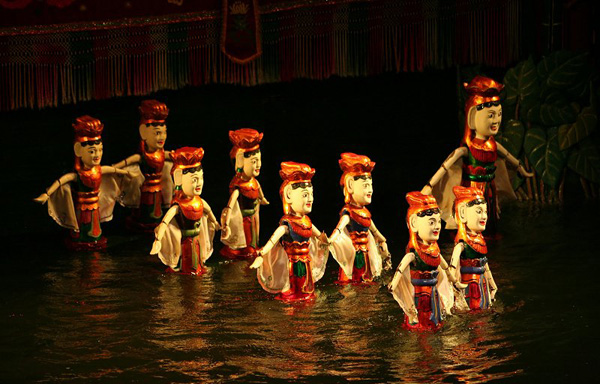1. Concept:
Water puppetry is a unique folk art form of Vietnam, dating back to around the 11th century.
Unlike traditional puppetry, the stage for this performance is the water surface, typically a pond, lake, or artificial water body.
The artists control the puppets from behind a bamboo screen, below the water surface.
2. Origin:
Water puppetry originated during the Lý Dynasty (11th century), stemming from Vietnam’s agricultural civilization based on wet-rice farming.
Initially, water puppetry was a form of entertainment during festivals after harvest in rural villages of the Red River Delta, particularly in the Hồng River Delta.
3. Characteristics:
Puppets: These are made from light wood (usually fig tree wood) to float easily on water, and they are painted with vibrant colors and treated to be waterproof.
Puppet manipulation: The artists stand under the water, hiding behind a screen, using a system of ropes and bamboo poles to control the puppets.
Music: Traditional instruments such as drums, two-stringed violins (đàn nhị), flutes, and the đàn bầu (monochord) are used to create lively and playful effects.
4. Themes of Performances:
The performances often depict rural life activities like plowing, buffalo herding, fishing, and village festivals.
Folk tales such as Thạch Sanh, Tấm Cám, and Lê Lợi returns the sword are frequently featured.
Many performances incorporate humor, social satire, or celebrate positive virtues.
5. Famous Characters:
Chú Tễu (Uncle Tễu) is a cheerful and comedic character in water puppetry. He usually serves as the narrator and comic relief, embodying a friendly and rustic persona.
6. Famous Puppet Troupes:
Thăng Long Water Puppet Theater (Hà Nội)
Vietnam Water Puppet Theater
Puppet troupes from Nam Định, Hải Dương, Hà Tây (formerly), and more.
7. Cultural Value:
Water puppetry is not only entertainment but also reflects deeply the soul, spiritual life, and folk wisdom of the Vietnamese people.
It is an art form highly regarded internationally when it comes to Vietnam’s cultural heritage.



